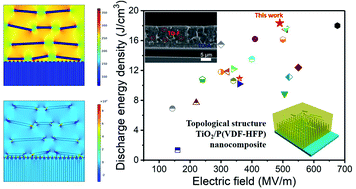Topologically distributed one-dimensional TiO2 nanofillers maximize the dielectric energy density in a P(VDF-HFP) nanocomposite†
Abstract
Larger energy densities are desirable for nanocomposites that can be used as potential dielectrics in energy storage capacitors. For this, it is necessary to overcome the adverse relationship between dielectric permittivity and breakdown strength in these materials. In this work, we combine the advantages of 1-dimensional nanofillers with a topologically structured composite film to maximize the energy density in a P(VDF-HFP) nanocomposite. A two layered nanocomposite, TO-A/TO-F/P(VDF-HFP), was fabricated with TO nanorod arrays (TO-A) embedded in the bottom layer and TO nanofibers (TO-F) contained in the top layer. The dielectric permittivity is 18.2 at 1 kHz and the breakdown strength is 489.9 MV m−1 in TO-A/TO-F/P(VDF-HFP), which are much higher than the corresponding values for the respective simple nanocomposites. Phase-field simulations were adopted to demonstrate the mechanism of the compatible improvements in the dielectric permittivity and breakdown strength in the nanocomposite generated by the use of TO-A and TO-F, respectively. The TO-A/TO-F/P(VDF-HFP) nanocomposite film presents an excellent energy storage value of 18.3 J cm−3 at 490 MV m−1 with efficiency of 79.7%, superior to other reference counterparts. This work provides a new strategy to maximize the improvement in energy storage performance through the use of 1D nanofillers in nanocomposites.



 Please wait while we load your content...
Please wait while we load your content...